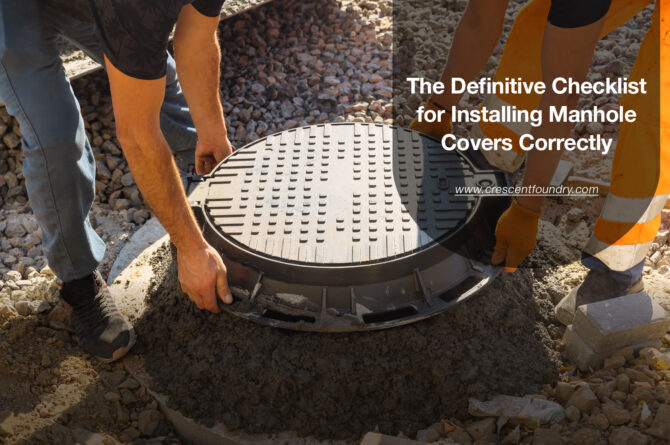Industrial and commercial spaces have the requirement for several casting…

The Definitive Checklist for Installing Manhole Covers Correctly
Manhole covers, when not installed and/or maintained correctly, can pose a wide range of risks. For starters, there can be serious safety concerns, particularly for municipal covers in roadways and high-traffic areas. Installation mistakes can also have adverse impacts on product longevity, and lead to breakages and earlier-than-normal wear & tear. That’s precisely why the top manhole cover manufacturers in India provide detailed guidance and assistance, to ensure that their clients do not face any problems during cover installation and maintenance. Here’s a checklist of all the factors that need to be considered, for setting up manhole covers in the correct manner:
Understand The Manhole Cover Type
At the very outset, it is vital to get a thorough idea of the type of manhole(s) you need to install, and its precise requirements. Check the load class / load rating of the covers (which can vary from A125 to F900), along with the shape of the opening, the frame structure, the chamber & bedding area, the grating, and other components. Consider the external weather / environmental conditions that the manhole covers will be exposed to, and make arrangements to protect it accordingly.
Arrange For All The Necessary Installation Tools
If you do not have the right materials / tools for manhole cover installation ready at hand, there are bound to be delays & inconveniences later. Apart from the cover itself, you need to gather all the other things that are required to set it up – including measuring tapes, wrenches, testing equipment, and others. Once you have everything you need at your disposal, the installation procedure can be promptly completed.
Get The Installation Site Prepared; Use The Right Bedding Mixture
Thorough cleaning of the site is important, before starting to install a manhole cover. Make sure that there is no dust, dirt or external debris that can prevent proper installation and/or restrict access in any way. Choose the bedding material for the cover on the basis of the latter’s features (e.g. cement mortar is commonly used as bedding). Signs of damage and mechanical fatigue on the cover frames also need to be examined, along with the seating depth and width. Broken manhole covers should never be used, under any circumstances.
Sealing Concrete and Base Layer
As a rule of thumb, the shaft of the manhole should be on the level of the carriageway (with no parts protruding above). There should be no tilting, particularly during the mounting phase. The thickness of sealing concrete should be determined with care (in most cases, <40mm). Consider adding water to the sealing concrete, in case there are bricks in the base layer. The manhole cover frame has to be put on the concrete sealing carefully.
Do Your Measurements
As top manhole cover manufacturers in India and abroad would agree, precision lies at the heart of successful, glitch-free cover installation. To ensure a proper fit into the opening, the manhole cover (along with its frame) has to be measured – so that there are no uncertainties regarding product dimensions. Check for unevenness in weight distribution, that can lead to instability and resultant accidents. A correctly positioned and fitted manhole cover invariably has a significantly longer service life.
Note: To ensure that the frame is level, use a mallet to adjust its height. Remove concrete spillage, if any.
Placement of Manhole Covers With The Right Alignment
Once the base and bedding material is ready, it’s time to carefully position the manhole covers in the specified place. While doing this, due care has to be taken to ensure that the cover and its frame are correctly designed. Given that there would be multiple nuts, bolts and screws fitted into the cover, securing them with industry-grade fasteners is recommended. Check for unnecessary movable parts that might be lying loose, and fix / tighten them properly.
Double-Check The Sealing Of Manhole Covers
The presence of gaps in the manhole cover seal can have serious adverse impacts on its longevity. That’s precisely why it is imperative to check for such glitch areas and rectify the problems (if any) as quickly as possible. When the seal of the cover is as tight as required, chances of problematic intrusions are eliminated, risks of progressive wear & tear are minimised, and there is a snug fit for the cover and the frame.
Ask About The Maintenance Requirements
Right at the time of installation, make it a point to find out the exact maintenance needs to extend its lifespan. In general too, the condition of the covers should be examined on a regular basis, to iron out risks of unidentified cracks and mechanical failure. When not maintained properly, the durability and functional features can go down over time. There can be accidental damages as well.
Conduct The Final Testing
In the final inspection phase, several key factors need to be rechecked. For example, the stability of the manhole covers need to be examined, while the load-bearing capacity of the cover also has to be tested. There should not be any damages in the cover or the frame or the joining parts. The objective of the inspection stage is to make sure that there are no problems with the installation.
While following these pointers is vital to set up manhole covers, it is also vital to source these products from a reliable, reputed cast iron products manufacturer in India. The onus also lies on the buyers to choose manhole cover(s) that would meet their precise requirements. Manhole covers can last for a long period of time, but only when they are of the desired quality and are installed properly.



